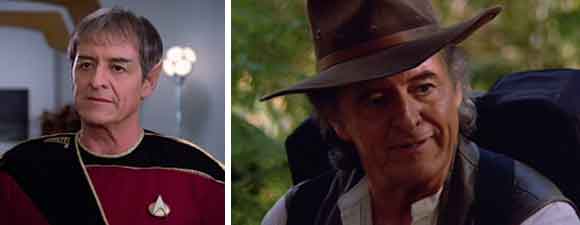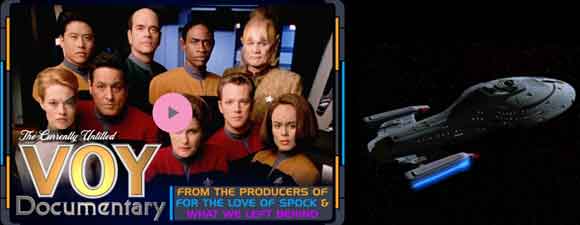Retro Review: Nemesis
6 min read
nemesisbanner
Chakotay’s shuttlecraft barely makes it intact to a planet in the midst of a bloody civil war.
Plot Summary: During a scouting mission, Chakotay’s shuttlecraft is shot down and crashes in the forest of an unknown planet. He is found by a group of young human-looking soldiers called the Vori. Initially suspicious of him, they explain in their colloquial language that their enemy, the Kradin, whom they call the Nemesis, are heartless beasts who kill their elderly and abuse their women and children. As Chakotay travels with them in the hope of finding a way to communicate with Voyager through heavy planetary interference, he witnesses several battles during which the Kradin kill Vori soldiers and desecrate the bodies of the dead. When Chakotay survives a massacre, he stumbles into a Vori village, where he meets the younger sister of a soldier from a unit he knows has been destroyed. The Kradin attack the village, send the elderly to be exterminated, and are violent with the girl. Chakotay watches innocent people die and grows to hate the jagged-toothed, well-armored Kradin so much that when a soldier offers to help take him to a communications station, he refuses, asking to stay and fight with the Vori instead. Meanwhile, Voyager tracks the missing shuttlecraft and contacts natives on the surface who explain that they are fighting their Nemesis, but will help search for Chakotay. When these allies beam aboard Voyager, they introduce themselves as the Kradin. Only when Tuvok uses Vulcan telepathy to help rescue Chakotay does the latter learn that the Vori have used mind-control techniques to recruit him to fight their battles. None of his experiences on the planet have been real. Though the facts of the conflict remain in question, Chakotay discovers that he still hates the alien-looking Kradin more than he resents the manipulative Vori.
Analysis: “Nemesis” isn’t a great episode and the ending seems gimmicky, but it shares that sensibility with several of the later original series episodes, which tend to be heavy-handed, yet are often forgivable precisely because they become entertaining when they go over the top (“That which you call E Plebnista was not written for the chiefs or the kings or the warriors or the rich and powerful, but for all the people!”). It’s missing the moment where the captain makes a big speech to smooth things over, but that does keep “Nemesis” grounded, though I’m always sorry when Janeway doesn’t get an opportunity to preach Federation values the way Kirk would have in situations that seem tailor-made for them instead of problematic with the non-interference directive when the ship is in the Delta Quadrant. “Nemesis” is rather confusing in that the Vori are aware that there are spacefaring races, yet as far as Chakotay can tell, they don’t go into space themselves and are living under primitive conditions since the Kradin destroyed their homes. We can ignore the Prime Directive issues at first because allying himself with the Vori represents Chakotay’s only hope for getting to communication equipment that will let him contact Voyager, and later on we know he’s been brainwashed, but I still keep expecting him to have a few moments of pondering his role in the conflict beyond explaining that on his sphere, people are drilled differently. His behavior is consistent with how he acted in “Initiations” when he was inadvertently drawn into a young Kazon’s tribal conflict, but I keep wishing there was more to him – both the Starfleet-educated Federation citizen who tries to understand enemies rather than fight them and the Maquis warrior who believes that some enemies, like the Cardassians, must be driven out with violence. I don’t like that all of his characterization here can be attributed to mind control.
For the second time in eight episodes, the story centers around an alien point of view, and we don’t see the ship till after the halfway point; instead, we identify with Chakotay as he learns about the Vori and starts resenting the Kradin, though it’s easy to guess before we see Voyager’s contact that the crew’s new friends will be Kradin and the Vori will be “the nemesis” to them. It’s nice to see visuals with so little focus on the grays and blacks of the ship, which makes me sorry there aren’t more away mission stories in general in the series – I know it’s more expensive to shoot on location (or, as the original series did, to make caves out of styrofoam and plastic plants), but since Voyager apparently has such a huge supply of shuttles that the crew can destroy them three weeks in a row, it shouldn’t be a problem to explain why they keep leaving the ship. The speed with which Chakotay becomes emotionally invested in an alien war even makes sense for his character, not only because of that Maquis past but because how how rapidly he let himself be lured in by the ex-Borg in “Unity.” I just wish that, on a regular basis, we might see more than a glimpse of the righteous terrorist Janeway was sent out to arrest. If, as Chakotay keeps saying, he’s always hated war and killing is one of the hardest things he ever learned to do, how come he could evacuate Borg out an airlock without qualms a couple of weeks ago, in defiance of an alliance that was so important to the captain? He claims to be a gentle man from a gentle people, yet he learns to hate very quickly, even in a throwback culture where women and children must be protected from an enemy characterized in recognizably racist terms. Does every newcomer learn to grok the same slang, or does “nullified” – which sounds almost Borg – scare Chakotay more than “murdered” would? Does the mind control adapt to the cultures of captives like himself, and if so, what does that say about him?
Jumping into colorful action and keeping the captain’s logs to a minimum makes the episode more dynamic compared to the many ship-bound stories we see each season, but it also makes “Nemesis” feel somewhat generic. These events could have happened in any science fiction show and, since there’s mind control involved, to any set of characters. Thus Paris is absurdly over-zealous in his desperation to retrieve Chakotay and Neelix behaves like an expert in a region that’s a decade away from the area of space he knows. By contrast, the original series’ Vietnam allegory episode “A Private Little War” gets a lot of its impact from the fact that Kirk knows the aliens personally; he’s manipulated into involvement in a foreign conflict not through mind control but because of who he is and who he loves. I don’t want to believe that Chakotay sees himself as the product of a standard human warrior patriarchy, but that’s what the storyline implies, and how sad that it’s assumed he (and we) will identify better with the human-looking Vori than the Nausicaan-looking Kradin. As with many Voyager stories, “Nemesis” is content to skim the surface of the issues instead of asking hard questions, like whether Janeway should have launched a buoy to warn away other innocent civilians from being ensnared in the Vori conflict. This is probably because such an action would draw attention to the illogic of Vori culture, expending enormous resources to brainwash aliens to fight their wars. The director tries to get shock value out of having a Kradin appear on Voyager’s transporter pad when we’re supposed to expect the Vori, but I think it would have been much more effective to leave Voyager out until the very end, when the Kradin “beast” turns out to be Tuvok. That would make viewers confront their own appearance prejudices and really put us into the mind of a character we know too little.






